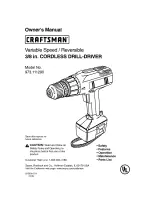
English |
15
Bosch Power Tools
1 609 92A 3YE | (29.8.17)
The vibration level given in this information sheet has been
measured in accordance with a standardised test given in
EN 60745 and may be used to compare one tool with anoth-
er. It may be used for a preliminary assessment of exposure.
The declared vibration emission level represents the main ap-
plications of the tool. However if the tool is used for different
applications, with different accessories or insertion tools or is
poorly maintained, the vibration emission may differ. This
may significantly increase the exposure level over the total
working period.
An estimation of the level of exposure to vibration should also
take into account the times when the tool is switched off or
when it is running but not actually doing the job. This may sig-
nificantly reduce the exposure level over the total working
period.
Identify additional safety measures to protect the operator
from the effects of vibration such as: maintain the tool and the
accessories, keep the hands warm, organisation of work pat-
terns.
Assembly
Battery Charging
Note:
The battery supplied is partially charged. To ensure full
capacity of the battery, completely charge the battery in the
battery charger before using your power tool for the first time.
The lithium-ion battery can be charged at any time without re-
ducing its service life. Interrupting the charging procedure
does not damage the battery.
The lithium-ion battery is protected against deep discharging
by the “Electronic Cell Protection (ECP)”. When the battery is
empty, the machine is switched off by means of a protective
circuit: The inserted tool no longer rotates.
Do not continue to press the On/Off switch after the
machine has been automatically switched off.
The bat-
tery can be damaged.
Removing the battery
The battery
7
is equipped with two locking levels that should
prevent the battery from falling out when pushing the battery
unlocking button
8
unintentionally. As long as the battery is
inserted in the power tool, it is held in position by means of a
spring.
To remove the battery
7
, press the unlocking button
8
and
pull out the battery toward the front.
Do not exert any force.
Changing the Tool (see figure A)
Before any work on the machine itself (e. g. mainte-
nance, tool change, etc.) as well as during transport
and storage, remove the battery from the power tool.
There is danger of injury when unintentionally actuating
the On/Off switch.
Open the keyless chuck
2
by turning in rotation direction
,
until the tool can be inserted. Insert the tool.
Firmly tighten the collar of the keyless chuck
2
by hand in ro-
tation direction
. This automatically locks the drill chuck.
Dust/Chip Extraction
Dust from materials such as lead-containing coatings,
some wood types, minerals and metal can be harmful to
one’s health and cause allergic reactions, lead to res-
piratory infections and/or cancer.
Materials containing
asbestos may only be worked by specialists.
–
Provide for good ventilation of the working place.
–
It is recommended to wear a P2 filter-class respirator.
Observe the relevant regulations in your country for the
materials to be worked.
Prevent dust accumulation at the workplace.
Dust can
easily ignite.
Operation
Starting Operation
Inserting the battery
Note:
Use of batteries not suitable for the machine can lead to
malfunctions of or cause damage to the power tool.
GSR 18V-21
GSB 18V-21
Vibration total values a
h
(triax vector sum) and uncertainty
K determined according to EN 60745-2-1, EN 60745-2-2.
Drilling in metal:
a
h
K
Impact drilling in concrete:
a
h
K
Screwdriving:
a
h
K
m/s
2
m/s
2
m/s
2
m/s
2
m/s
2
m/s
2
3.3
1.5
–
–
1.0
1.5
3.3
1.5
6.7
1.5
1.0
1.5
OBJ_BUCH-3248-001.book Page 15 Tuesday, August 29, 2017 7:47 AM
















































